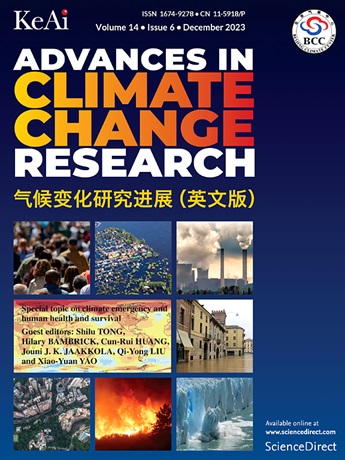Weakening trends of glacier and snowmelt-induced floods in the Upper Yarkant River Basin, Karakoram during 1961–2022
IF 5.2
1区 地球科学
Q1 ENVIRONMENTAL SCIENCES
引用次数: 0
Abstract
Glacier and snowmelt-induced floods (GSFs) in glacierized regions are highly sensitive to climate change, yet their dynamics in areas such as the Upper Yarkant River Basin (UYRB) remain inadequately understood. Existing studies are constrained by data limitations and oversimplified modeling approaches, underscoring the need for a comprehensive analysis of the long-term changes in GSFs to improve flood risk management and water resource planning in the UYRB. This study investigated the characteristics, temporal changes, and climatic responses of GSFs based on a well-validated hydrological model. Results reveal that GSFs in the UYRB experienced a weakening trend from 1961 to 2022, as indicated by decreases in flood peak, duration, volume, and frequency. Although a portion of GSFs were primarily driven by snow runoff, the majority were mainly governed by glacier runoff. Among the examined climatic factors, temperature during the flood period was the key factor influencing GSF changes. Notably, despite the overall warming and wetting trend in the UYRB, temperatures during GSF events showed a decreasing trend, which suppressed glacier runoff and contributed to the weakening trends of GSFs. Spatial analysis identified the 4500–6000 m a.s.l. elevation zone as hydrologically critical, accounting for approximately 71% of the total runoff during the flood season. Under a 2 °C warming scenario, the intensity of GSFs is expected to increase across all return periods, with greater increases for longer return periods. A 10% increase in precipitation is projected to marginally enhance the intensity of GSFs with return periods of 20 years or less, while decreasing the intensity of extreme floods with 50- to 100-year return periods. Conversely, a 10% decrease in precipitation will reduce the intensity for all return periods. When the 2 °C warming scenario is combined with ±10% changes in precipitation, intensity of GSFs rises across all return periods, with more pronounced effects for longer return periods—especially under conditions of increased precipitation. These findings are pivotal in shaping effective strategies for flood adaptation and mitigation in alpine river basins.
1961-2022年喀喇昆仑地区上雅尔喀特河流域冰川融雪洪水减弱趋势
冰川化地区的冰川和融雪引发的洪水对气候变化高度敏感,但其在上雅尔喀特河流域(UYRB)等地区的动态尚不充分了解。现有研究受到数据限制和过于简化的建模方法的制约,强调需要对gsf的长期变化进行全面分析,以改善UYRB的洪水风险管理和水资源规划。本研究基于一个经过验证的水文模型,研究了gsf的特征、时间变化和气候响应。结果表明:1961 ~ 2022年,新疆干旱区gsf呈减弱趋势,表现为洪峰减少、持续时间减少、体积减少、频次减少;虽然部分gsf主要受积雪径流驱动,但大部分gsf主要受冰川径流控制。在研究的气候因子中,汛期温度是影响GSF变化的关键因子。值得注意的是,尽管青藏高原整体呈现增湿趋势,但GSF事件期间气温呈现下降趋势,这抑制了冰川径流,导致GSF的减弱趋势。空间分析表明,海拔高度在4500-6000 m的区域是水文临界区,约占汛期总径流量的71%。在升温2°C的情景下,预计gsf的强度在所有回归期都将增加,且回归期越长,增加幅度越大。预计10%的降水增加将略微增强重现期为20年或更短的gsf的强度,而减少重现期为50- 100年的极端洪水的强度。相反,降水减少10%将使所有回归期的强度降低。当2°C变暖情景与降水±10%的变化相结合时,gsf的强度在所有回归期都有所上升,在较长的回归期影响更为明显,尤其是在降水增加的条件下。这些发现对于制定高寒河流流域洪水适应和缓解的有效策略至关重要。
本文章由计算机程序翻译,如有差异,请以英文原文为准。
求助全文
约1分钟内获得全文
求助全文
来源期刊

Advances in Climate Change Research
Earth and Planetary Sciences-Atmospheric Science
CiteScore
9.80
自引率
4.10%
发文量
424
审稿时长
107 days
期刊介绍:
Advances in Climate Change Research publishes scientific research and analyses on climate change and the interactions of climate change with society. This journal encompasses basic science and economic, social, and policy research, including studies on mitigation and adaptation to climate change.
Advances in Climate Change Research attempts to promote research in climate change and provide an impetus for the application of research achievements in numerous aspects, such as socioeconomic sustainable development, responses to the adaptation and mitigation of climate change, diplomatic negotiations of climate and environment policies, and the protection and exploitation of natural resources.
 求助内容:
求助内容: 应助结果提醒方式:
应助结果提醒方式:


